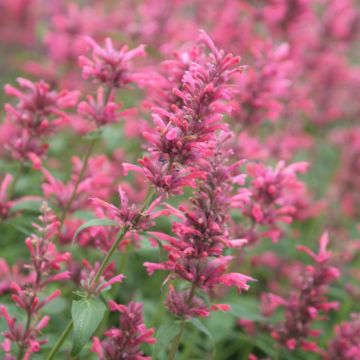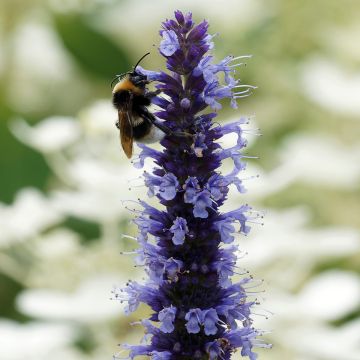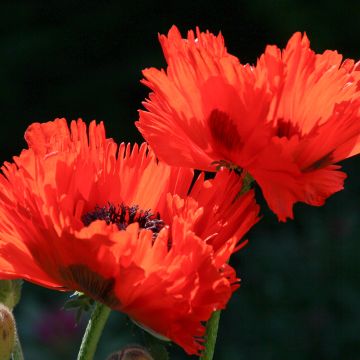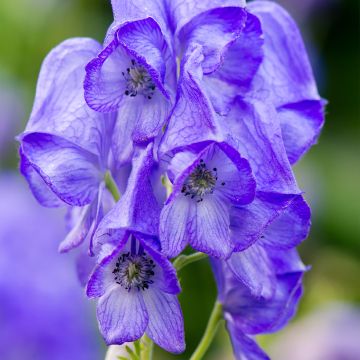

Agastache Serpentine


Agastache Serpentine
Agastache Serpentine
Agastache Serpentine
Anise Hyssop, Giant Hyssop
Planted in April 2023, the young plant did not survive.
Mathieu, 26/02/2025
Special offer!
Receive a €20 voucher for any order over €90 (excluding delivery costs, credit notes, and plastic-free options)!
1- Add your favorite plants to your cart.
2- Once you have reached €90, confirm your order (you can even choose the delivery date!).
3- As soon as your order is shipped, you will receive an email containing your voucher code, valid for 3 months (90 days).
Your voucher is unique and can only be used once, for any order with a minimum value of €20, excluding delivery costs.
Can be combined with other current offers, non-divisible and non-refundable.
Home or relay delivery (depending on size and destination)
Schedule delivery date,
and select date in basket
This plant carries a 12 months recovery warranty
More information
We guarantee the quality of our plants for a full growing cycle, and will replace at our expense any plant that fails to recover under normal climatic and planting conditions.
Would this plant suit my garden?
Set up your Plantfit profile →
Description
The 'Agastache 'Serpentine' is a recent variety that is truly imposing, distinguished by its tall stature and floribundity. Both a honey plant, aromatic and ornamental perennial, it has a very upright, dense and bushy habit and a very bushy silhouette. This variety produces tall, slightly twisted spikes throughout the summer, with tightly packed small flowers in bright lavender blue. A fragrant, spectacular, unusual and endearing plant, which is sure to arouse the curiosity of the gardener who grows it, as well as that of their neighbours!
The Agastache 'Serpentine' is a very recent Dutch horticultural hybrid belonging to the mint family. This herbaceous perennial, relatively hardy in well-drained soil, forms a large upright clump, 1.2 to 1.5 metres (4 to 5 feet) tall (sometimes 1.8 metres (6 feet) under optimal conditions) and 90 cm (35in) wide. It forms a large bushy shrub and produces elongated, triangular-shaped leaves, 8 cm (3in) long, with toothed edges, dark green, which grow along the length of the angular flowering stems. When crushed, they give off a pleasant anise fragrance. The flowering period extends from June to September, without interruption, in the form of upright and twisted inflorescences, in thin and dense spikes. Each small lavender-blue tubular flower is surrounded by violet bracts. This particularly nectar-rich flowering attracts a large number of bees and butterflies.
The Agastache 'Serpentine' is grown in sheltered and sunny borders with a slightly wild look, but also in pots on the terrace. In hot regions, it should never be without water during flowering. In cooler regions, the soil should be particularly healthy and well-drained. It is a trouble-free perennial where it is happy, providing height and consistency to borders composed of grasses (stipas, eragrostis, pennisetums), herbaceous salvias, large daisies, viper's bugloss (Echium vulgare), phacelia, sainfoin, goldenrod, and asters. It also pairs very well with shrub cinquefoils in yellow or orange, for example. In the vegetable garden, it can be planted alongside thyme, savory, chervil, or basil. Dried flowers can be well-preserved in bouquets. The leaves are traditionally used in cooking as a substitute for anise, or in herbal teas after drying.
The highly fragrant flowers and leaves of Agastache are edible and delicious in salads or fish dishes.
Report an error about the product description
Agastache Serpentine in pictures




Flowering
Foliage
Plant habit
Botanical data
Agastache
Serpentine
Lamiaceae
Anise Hyssop, Giant Hyssop
Cultivar or hybrid
Other Agastache
View all →Planting and care
'Serpentine' Agastache is a plant that enjoys warmth and dreads waterlogged soils in winter. In heavy soil, dig a hole 30 cm (12in) in all directions, pour pure sand into it, and install the stump without adding any soil. This plant requires a sunny position sheltered from heavy frosts. During severe winters, cover the stumps with straw or dead leaves to form a thick mulch. The soil should be fertile, loose, well-drained, but rather moist to support flowering. The plant can tolerate periods of temporary drought, which nevertheless harm flowering.
Planting period
Intended location
Care
-
, onOrder confirmed
Reply from on Promesse de fleurs
Similar products
Haven't found what you were looking for?
Hardiness is the lowest winter temperature a plant can endure without suffering serious damage or even dying. However, hardiness is affected by location (a sheltered area, such as a patio), protection (winter cover) and soil type (hardiness is improved by well-drained soil).

Photo Sharing Terms & Conditions
In order to encourage gardeners to interact and share their experiences, Promesse de fleurs offers various media enabling content to be uploaded onto its Site - in particular via the ‘Photo sharing’ module.
The User agrees to refrain from:
- Posting any content that is illegal, prejudicial, insulting, racist, inciteful to hatred, revisionist, contrary to public decency, that infringes on privacy or on the privacy rights of third parties, in particular the publicity rights of persons and goods, intellectual property rights, or the right to privacy.
- Submitting content on behalf of a third party;
- Impersonate the identity of a third party and/or publish any personal information about a third party;
In general, the User undertakes to refrain from any unethical behaviour.
All Content (in particular text, comments, files, images, photos, videos, creative works, etc.), which may be subject to property or intellectual property rights, image or other private rights, shall remain the property of the User, subject to the limited rights granted by the terms of the licence granted by Promesse de fleurs as stated below. Users are at liberty to publish or not to publish such Content on the Site, notably via the ‘Photo Sharing’ facility, and accept that this Content shall be made public and freely accessible, notably on the Internet.
Users further acknowledge, undertake to have ,and guarantee that they hold all necessary rights and permissions to publish such material on the Site, in particular with regard to the legislation in force pertaining to any privacy, property, intellectual property, image, or contractual rights, or rights of any other nature. By publishing such Content on the Site, Users acknowledge accepting full liability as publishers of the Content within the meaning of the law, and grant Promesse de fleurs, free of charge, an inclusive, worldwide licence for the said Content for the entire duration of its publication, including all reproduction, representation, up/downloading, displaying, performing, transmission, and storage rights.
Users also grant permission for their name to be linked to the Content and accept that this link may not always be made available.
By engaging in posting material, Users consent to their Content becoming automatically accessible on the Internet, in particular on other sites and/or blogs and/or web pages of the Promesse de fleurs site, including in particular social pages and the Promesse de fleurs catalogue.
Users may secure the removal of entrusted content free of charge by issuing a simple request via our contact form.
The flowering period indicated on our website applies to countries and regions located in USDA zone 8 (France, the United Kingdom, Ireland, the Netherlands, etc.)
It will vary according to where you live:
- In zones 9 to 10 (Italy, Spain, Greece, etc.), flowering will occur about 2 to 4 weeks earlier.
- In zones 6 to 7 (Germany, Poland, Slovenia, and lower mountainous regions), flowering will be delayed by 2 to 3 weeks.
- In zone 5 (Central Europe, Scandinavia), blooming will be delayed by 3 to 5 weeks.
In temperate climates, pruning of spring-flowering shrubs (forsythia, spireas, etc.) should be done just after flowering.
Pruning of summer-flowering shrubs (Indian Lilac, Perovskia, etc.) can be done in winter or spring.
In cold regions as well as with frost-sensitive plants, avoid pruning too early when severe frosts may still occur.
The planting period indicated on our website applies to countries and regions located in USDA zone 8 (France, United Kingdom, Ireland, Netherlands).
It will vary according to where you live:
- In Mediterranean zones (Marseille, Madrid, Milan, etc.), autumn and winter are the best planting periods.
- In continental zones (Strasbourg, Munich, Vienna, etc.), delay planting by 2 to 3 weeks in spring and bring it forward by 2 to 4 weeks in autumn.
- In mountainous regions (the Alps, Pyrenees, Carpathians, etc.), it is best to plant in late spring (May-June) or late summer (August-September).
The harvesting period indicated on our website applies to countries and regions in USDA zone 8 (France, England, Ireland, the Netherlands).
In colder areas (Scandinavia, Poland, Austria...) fruit and vegetable harvests are likely to be delayed by 3-4 weeks.
In warmer areas (Italy, Spain, Greece, etc.), harvesting will probably take place earlier, depending on weather conditions.
The sowing periods indicated on our website apply to countries and regions within USDA Zone 8 (France, UK, Ireland, Netherlands).
In colder areas (Scandinavia, Poland, Austria...), delay any outdoor sowing by 3-4 weeks, or sow under glass.
In warmer climes (Italy, Spain, Greece, etc.), bring outdoor sowing forward by a few weeks.



















































